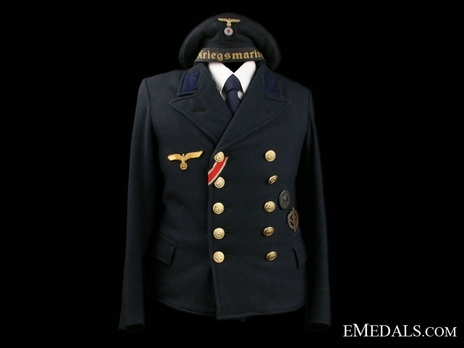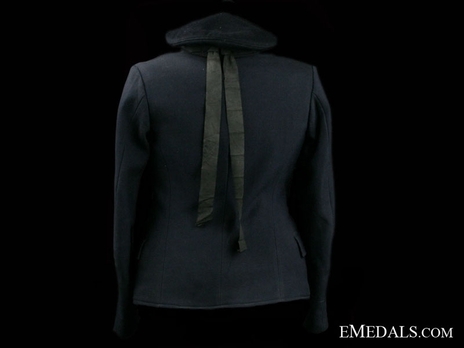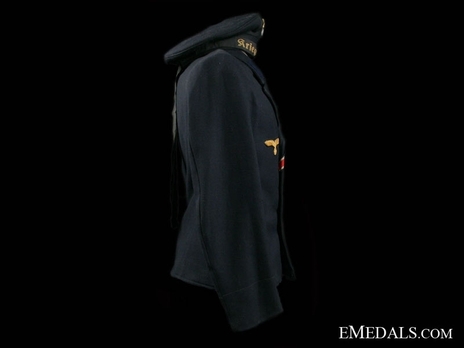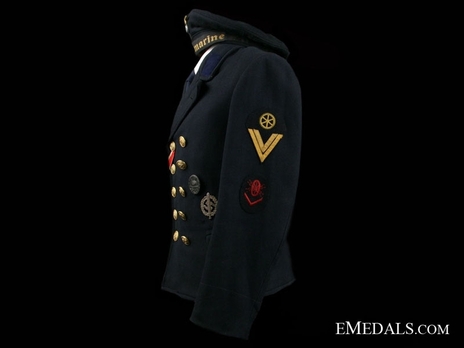Kriegsmarine Pea Jacket
CATEGORY: Version
SKU: 21.GOR.02.01.03.005.000
Estimated market value:




Estimated market value:
The jacket retains its size and issue markings, well stamped in the sleeve lining. These cotton sleeve linings are stripped and show discolouration in the underarm regions. The jacket is fully lined. The Machine Engine EM's Career sleeve insignia, rank chevrons, electric technician grade III Specialty trade badge, as well as the breast eagle are carefully hand sewn into place and are very fine. Cornflower blue collar tabs are also hand sewn securely in place. This fine Collani is in excellent condition.
The headgear, uniforms, and insignia worn by members of the Kriegsmarine were based upon the designs utilized by the Kaiserliche Marine (Imperial Navy) and the Reichsmarine (Navy of the Weimar Republic). The official regulations governing the uniforms of the Reichsmarine were issued on April 5, 1921, and they were embraced, with a few alterations, as the Kriegsmarine uniforms in 1935.
From 1933 to 1945, the uniforms worn by personnel in the German Navy were produced and disseminated by the Navy Clothing Depot and private manufacturers. The cloth was of a high quality prior to the Second World War, but during the war, it became increasingly synthetic and of lower quality. Similarly, the cloth used in the uniforms of Officers and Admirals was of a higher quality than the cloth used in the uniforms of lower ranking personnel, such as Non-Commissioned Officers and Enlisted Men. The cloth utilized in garments of the blue uniform is of an overall better quality than the cloth utilized in the field-grey uniform. For the field-grey uniform specifically, the cloth is more grey-coloured in pre-war uniforms, while the cloth is more green/olive-coloured in wartime uniforms.
The main colour of Kriegsmarine uniform pieces is a dark navy blue. However, during the summer months, and initially also in regions with warmer climate, a white summer uniform was used. Eventually, a brown tropical uniform was introduced for units stationed in tropical and subtropical regions. Land-based Kriegsmarine units, most of which were part of the Coastal Artillery, wore Army-like field-grey uniforms in the style of the Kriegsmarine.
The garments may have proof stamps, serial and unit stamps, and manufacturer marks denoting the legitimacy and origin of the item. They also tend to feature sewn name tabs (Namensläppchen) on all clothing items associated with the blue and field-grey uniforms. The blue uniform garments all have a serial number stamp (Stammrollennummernstempel), while the field-grey uniform garments have a unit stamp.
The proof stamp is present on all garments produced by the Navy Clothing Depot, and it includes the size of the item, if needed, with the year of manufacture above the size, and a surmounting script that reads “B.A.K.” or “B.A.W.”. This stamp information is framed, and written in white ink on blue or black garments and in black ink on all other colour garments.
The serial stamp is composed of letters and numbers, and it is present on blue uniform garments from the Depot. The stamp is either printed in red ink or sewn in red thread. The numbers are preceded by a letter that denotes the area in which the wearer served, with an “N” for Navy Station or an “O” for Navy Station Baltic. The stamp ends in a letter associated with the wearer’s career group, with an “S” for deck personnel and a “T” for technical professionals. Below the serial number is the year in which the wearer entered the navy, surmounted by a horizontal line.
The unit stamp is present on field-grey uniforms. It includes the framed, shortened unit name of the wearer in red ink.
The marks of private manufacturers vary widely, ranging from codes to full names, and even abbreviated letters, as well as the year of manufacture. After 1942, Reich numbers (Reichsbetriebsnummern) were also used as manufacturer marks (RB-).
The buttons worn on Kriegsmarine garments are generally gold-coloured, except for the uniforms of Officials which used silver-coloured buttons. The buttons feature the image of a fouled anchor on the obverse. The buttons are composed of brass, or of light metal. The gold-coloured buttons were gilded, while the silver-coloured buttons were silvered. As well, in the case of special uniform garments the buttons may be composed of plastic.
The Pea Jackets are a form of short jacket, and they were worn during rough and stormy weather by Cadets, Privates, and Junior Non-Commissioned Officers.
There are two main models of this jacket. The jackets manufactured prior 1939 feature two front panels and a single back panel, while the jackets made post-1939 have two front panels and two back panels, and the back panels have a center seam. The first form of the jacket are slightly longer than the second form of the jacket, but they are both described as 3/4 length.
The pea jackets are composed of several main elements, including the cloth, the lining, the collar, the pockets, the buttons, the collar tabs, the national emblem, the career insignia, and the rank insignia (Chevrons).
The majority of these jackets are composed of navy blue wool/wool-like cloth, but the jackets for Cadets were manufactured privately, and thus feature higher quality cloth. The higher quality cloth assured that the Cadet jackets could be made into Reefer Jackets upon promotion.
The lining was made from dark cotton cloth for the body of the jacket, and white/off-white cloth, which may be stripped, for the sleeve lining.
The collar of this jacket features a gold-coloured tress border on the jackets worn by Junior Non-Commissioned Officers (Maat and Obermaat), and a plain collar for Privates and Cadets. The collar for all ranks was manufactured with a stiffening lining.
The jacket generally features four pockets, two breast pockets within the interior lining of each front panel, and two horizontal pockets at hip height. The hip pockets feature a rectangular flap cover. An additional pocket was sometimes added below the hip pocket on the left panel, also with a rectangular flap.
There are two vertical rows of gold-coloured (gilt) anchor buttons on the left front panel, and one row of button holes on the right front panel. Prior to the beginning of the Second World War a pair of hidden buttons was added below the jacket collar, but these buttons were omitted from jackets composed during the war.
The collar tabs are made from light blue badge cloth. These patches were worn on the jackets of Junior Non-Commissioned Officers and Privates, but not on the jackets of Cadets. Additional lines of tress were added to the patches to differentiate between ranks, with no tress for Matrose (Seamen) ranks, a single line of tress for Maat (Petty Officer), and two lines of tress for Obermaat (Chief Petty Officer). See the Collar Tabs folder for more information.
The national emblem is located on the right front panel, and it is generally embroidered on cloth backing that matches the colour of the uniform and sewn onto the jacket. The rank and career insignia are located on the left sleeve. See the Career Insignia and Chevrons sections for more information.

Comments
Sign in to comment and reply.


Scroll Top